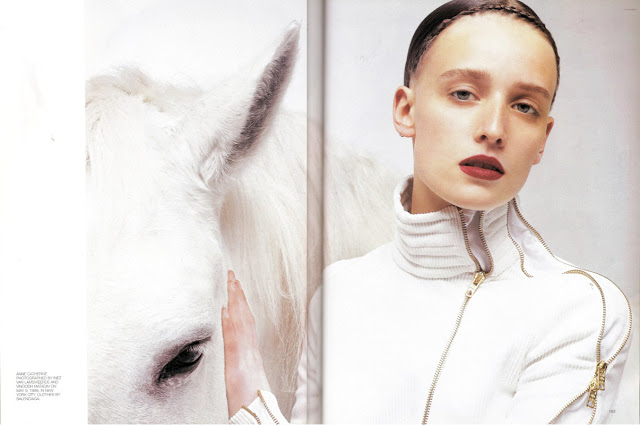Roxanne Lowit is one of the pioneers of behind-the-scenes fashion photography as we know it today. “For the first 10 to 15 years I was the only one shooting backstage at all the shows. I had no credentials to begin with but quickly realised that that was my métier, that’s what I found most fascinating.”
The revelation came when she was gifted an Instamatic camera while still attending the Fashion Institute of Technology (FIT) in New York studying Textile Design. At the time Lowit was a keen painter, but with this new tool discovered a more efficient way of capturing the spirit of her subjects. “I wanted to paint the people I admired but nobody had the time, so I thought I’d take a photograph of them and work from the photograph,” she says. “However, once I took the photograph I realised that I didn’t need to capture the whole soul in a painting. So I traded in my paintbrushes for a camera.”
Her background in textile design became her backstage pass when she was invited by the designers who worked from her patterns to photograph the completed garments before their shows. Eventually word got out that Lowit’s images were something worth publishing, and in 1978 she was contacted by Annie Flanders from the SoHo News. “She heard that I was going to Paris so she said ‘if you get a real camera I’ll use your pictures when you get back’. I learnt how to put film in a real camera on the plane on the way over. Next thing I was on the top of the Eiffel Tower shooting with Yves Saint Laurent and Andy Warhol. It was all downhill from there because how could it get any better?”
But things did get better, much better. After that first trip to Paris doors flung open for Lowit and her career as a backstage fashion photographer gained swift momentum. As industry insiders came to know and love her, the invitations to the parties flooded in, which was where much of the magic happened in front of Lowit’s lens. The 80s were heady times for fashion and she was always there, stationed in the fray, ready to catch the fanfare, frivolities and outright excess as it happened. “It was phenomenal,” she recalls. “We had the Supermodels and all those designers who loved the Supermodels. There were great parties – Elton John was always there and all sorts of celebrities started coming to the shows and parties.”
These days Lowit finds the more homogenised collections produced by contemporary designers as a result of an increasingly commercialised fashion industry much less inspiring, but revels in rising to the challenge all the same. “I usually play a game with myself, how good can I make this look?” she laughs. “But really it’s just about taking a great picture and finding a great moment. It’s always exciting to think, where am I going to go and what am I going to shoot next?”For the fashion designers themselves, as Lowit recalls, it was a time of tremendous creative freedom, where their unique artistic vision was nurtured by the industry and experimentation was encouraged. The shows, it seems, were less about selling clothes and more about the artistry, theatre and spectacle of it all. “It was so much more creative back then. You didn’t need a name at the end of the runway to know who it was you were watching,” she tells me. “When you saw long red nails with vampish clothes and great big hair you knew it was Thierry Mugler. When you saw flower dresses and a girl on a horse you knew you were at Kenzo. Stripes and knits, you were at Sonia Rykiel.”
Lowit gets a kick out of shooting just about anyone who gets a kick out of being shot. “All the pictures I’ve taken are important to me. They’re all like my children. It’s always the next image I look forward to. But looking back I think my favourites are the ones where the people just enjoyed having their picture taken – they were just having a good time. That’s really when I can capture something great.”
 Roxanne Lowit, Andy Warhol, Jacqueline and Julian Schnabel, Kenny Scharf, Jean Michel Basquiat
Roxanne Lowit, Andy Warhol, Jacqueline and Julian Schnabel, Kenny Scharf, Jean Michel Basquiat
 Andy Warhol
Andy Warhol
 Yves Saint Laurent
Yves Saint Laurent
 Yves Saint Laurent and Karl Lagerfeld
Yves Saint Laurent and Karl Lagerfeld
 Helena Christensen, Karl Lagerfeld and Anna Wintour
Helena Christensen, Karl Lagerfeld and Anna Wintour
 Diana Vreeland
Diana Vreeland
 Ralph Lauren and Diana Vreeland
Ralph Lauren and Diana Vreeland
 Salvador Dalí, Janet Daly and the recipient of a kiss
Salvador Dalí, Janet Daly and the recipient of a kiss
 Helmut Newton
Helmut Newton
 Richard Avedon, Irving Penn and Helmut Newton
Richard Avedon, Irving Penn and Helmut Newton
 Peter Lindbergh, Arthur Elgort and Patrick Demarchelier
Peter Lindbergh, Arthur Elgort and Patrick Demarchelier
 Robert De Niro and Al Pacino
Robert De Niro and Al Pacino
 Patrick Kelly, Iman, Grace Jones and Naomi Campbell
Patrick Kelly, Iman, Grace Jones and Naomi Campbell

 Naomi Campbell, Christy Turlington and Linda Evangelista
Naomi Campbell, Christy Turlington and Linda Evangelista
 >Manolo Blahnik and Anna Piaggi
>Manolo Blahnik and Anna Piaggi
 Lauren Hutton and a chauffeur
Lauren Hutton and a chauffeur
 Elton John in concert wearing the Donald Duck costume, Central Park, New York
Elton John in concert wearing the Donald Duck costume, Central Park, New York
 Shalom Harlow
Shalom Harlow
 Amanda Lepore
Amanda Lepore
 Halston
Halston
 John Galliano
John Galliano
 Annabelle Neilson Rothschild and John Galliano
Annabelle Neilson Rothschild and John Galliano
 Backstage from Dior Show, Paris
Backstage from Dior Show, Paris
 Kate Moss and John Galliano
Kate Moss and John Galliano


 Kate Moss
Kate Moss
 Ellen Von Unwerth and Mario Testino
Ellen Von Unwerth and Mario Testino
 Herb Ritts, Christy Turlington and Steven Meisel
Herb Ritts, Christy Turlington and Steven Meisel




 Ad Campaign: Moschino F/W 2014-15
Ad Campaign: Moschino F/W 2014-15




































































